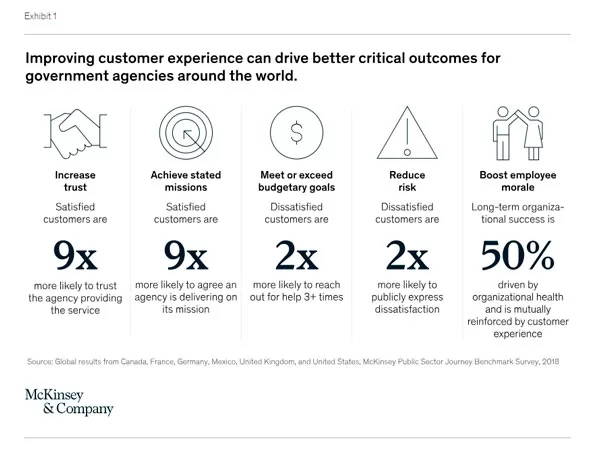Customer expectations have grown as technology has improved, but better CX also promises to drive efficiencies and cost savings across the federal government
by Intelliworx
Air travel is a sound analogy for explaining customer experience (CX). This is because individuals traveling to the airport will have many different experiences:
- Planning a trip and purchasing a ticket;
- Airport parking;
- Checking bags with a skycap;
- Going through security screening;
- Getting coffee or a snack at an airport restaurant;
- Checking in at the gate, boarding, takeoff, in-flight service and landing;
- Picking up luggage at the carousel; and
- Using public transport – taxis, shuttles, buses or a rideshare.
When the steps are listed this way, it’s easy to see that traveling is made up of a collection of interactions. This is, in part, why customer experience has become increasingly important. CX looks across the silos of stakeholder interactions to understand how they collectively affect the overall experience.
The government too has grown increasingly interested in CX. Its definition of the term is simple: similar: “Customer experience (CX) is a person’s perception of an organization as a total sum of all of their experiences with that organization.”
In the last few years, the government has added new channels of communication which have in turn created silos of interaction. Whether a citizen is seeking assistance in a physical office, on the phone with support, or completing a digital form online, the experience should be consistent.
Insiders point out some federal agencies have been dabbling with CX since the 1990s. However, the pace of recent legislation, regulations and guidance has grown measurably. These rules suggest there are fundamental drivers at work behind the CX initiative. We’ve listed what we think are the three most significant drivers below.
Never miss a post: Subscribe to our weekly newsletter by email.
1. Expectations are higher for digital experience
Technology has come a long way. Most of us are walking around with more processing power in our pockets than was onboard the Saturn V rocket which put people on the moon. In many ways, it’s those devices that have raised our expectations through the consumerization of technology.
Traditionally, technology for business and government was clunky. While designed to solve a problem, it didn’t account for how people – the end user – interact with technology. As a result, if your agency procured a new software product, you’d also have to invest in extended training to show people how to use it.
Then device manufacturers started manufacturing phones and tablets that were powerful machines, but also easy to use. Suddenly, every day people could figure out how to use the device with a swipe of a finger rather than a degree in technology.
Consumers started to wonder: How is it that I can figure out how to use this high-tech phone in a matter of minutes – but I need a week’s training to figure out how to use the software my employer has implemented?
As more and more of our work gravitated online, expectations for usability followed. Today, people simply expect forms, websites and apps fielded by the government to be intuitive. When they aren’t it ruins user confidence.
2. Trust in government is at an all-time low
Understanding is a prerequisite to trust. People don’t trust things they can’t understand. If the government creates unclear forms, rules or processes that sow the seeds of distrust. Trust in government, as measured by Pew Research, has been falling for decades.
Consistent, authoritative and findable information are the building blocks of trust – according to CX guidance from the Office of Management and Budget (OMB). The guidance provides agencies with clear direction and deadlines for meeting the standard the federal government has set for CX.
Improving CX won’t miraculously fix everything, but it can make measurable improvements. When the experience people have with various government agencies is good, they’ll naturally begin to be more trusting.
This shows up in research too. For example, a study by the consulting firm McKinsey found that “government customers are on average nine times more likely to trust a government agency if they are satisfied with its service.”
3. CX drives efficiency and reduces costs
One of the misnomers about CX is that it’s a soft and fluffy topic – like rainbows and unicorns. Nothing could be further from the truth.
For federal agencies, CX is about delivering on the mission of an agency, says Martha Dorris. She spent years as a civil servant working on CX for the General Services Agency (GSA) before starting a CX consulting firm.
When citizens don’t understand a website, or how to complete a government form, they pick up the phone and call the agency, she notes. Those extra interactions cost the government more money and take up more of a citizen’s time – what OMB has labeled a “time tax.”
That can also delay government revenue collection. If a citizen doesn’t understand the individual tax form – they will first seek out answers before writing a check to pay their taxes. In other words, it’s in the U.S. Treasury’s interest to ensure agencies across the government work to improve the overall experience they deliver.
4. Decades of progress afforded an overnight transformation
If the federal government’s interest in CX seems sudden, it’s because the global pandemic thrust digital interactions into the spotlight. The pandemic worked like an accelerant to a digital transformation that was already underway.
For example, the consumerization of technology took years to unfold as device makers launch more capable devices every year. Similarly, the decline in trust has mirrored the proliferation of technology. So, while CX is having a moment in government circles, it took decades of progress to set the conditions for this moment.
* * *
Intelliworx got started in the CX field 20 years ago by helping federal agencies convert paper forms into dynamic digital forms. Today we have 39 authorizations to operate (ATO) and serve federal agencies big and small with a range of solutions including application management, government workflow and financial disclosure.
We’d welcome the opportunity to show you rather than tell you – you are welcome to request a no-obligation demo or sign up for our weekly email newsletter to stay in touch.
If you enjoyed this post, you might also like:
An interview with the ‘Godmother of Government CX’ on agencies and modernization




